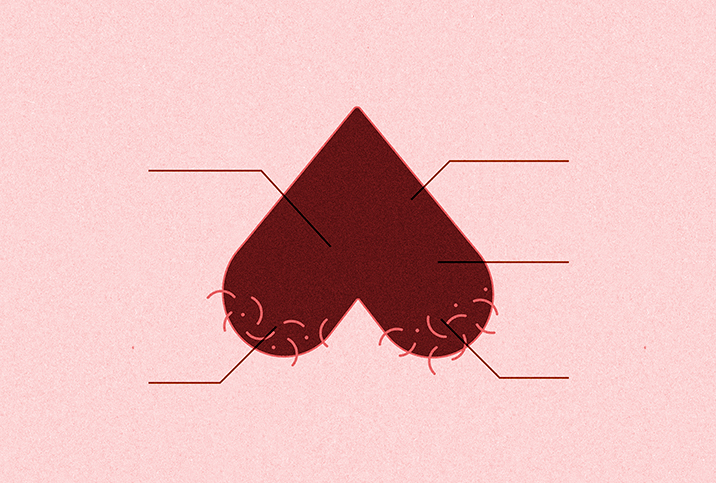Which Type of Hydroceles Do You Have? And What's the Difference?

In a relationship, communicating is better than not communicating. When it comes to a particular condition that affects the scrotum and its inhabitants, however, both of those words mean something unpleasant.
A hydrocele is a collection of fluid that forms in the scrotum, the pouch of skin that contains the testicles. This condition causes swelling and can make one of the testicles appear larger than the other. While fairly common in newborns, especially those born prematurely, this condition sometimes develops in males after adolescence, perhaps due to injury to the scrotum or inflammation. You might notice a hydrocele during a regular testicular self-exam—which, hopefully, you are incorporating into your life already.
It's important to know that hydroceles have two forms: communicating and noncommunicating. Let's dive into the different types and the specific treatments to help you find relief.
Communicating hydrocele
A communicating hydrocele happens while the baby is in the womb and is due to the failure of the processus vaginalis—a thin membrane that extends through the inguinal canal in the abdomen and into the scrotum—to close. If the membrane remains open, fluid will pass between the abdominal cavity and scrotum, forming a hydrocele; communicating refers to the opening into the abdominal cavity.
A communicating hydrocele may fluctuate in size, decreasing at night and getting larger when the individual is more active. It might also look smaller when a doctor presses on the scrotum, as the pressure might cause the fluid to flow back into the abdomen.
Noncommunicating hydrocele
A noncommunicating hydrocele might be present at birth and is usually painless and harmless. In the majority of cases, the fluid is absorbed during the first one to two years of age. In some cases, it stays beyond two years of age and surgery is needed. If an older child has a hydrocele, it could be a sign of other issues, such as infection, tumor or testicular torsion, a twisting of the testicles that is an extremely painful medical emergency.
When a noncommunicating hydrocele occurs in adult men, the cause is often unknown. Perhaps the inguinal canal reopened due to older age, an infection, an injury or surgery to repair a hernia. Hydroceles are not painful, but it's still alarming for men to notice a change in their scrotum. You should also rest easy that hydroceles are not a sign of more serious testicular issues such as testicular cancer, which starts as a hard lump on the testicle, or orchitis, which causes pain and swelling as a result of a bacterial or viral infection and may impact your fertility. Still, it's a good idea to visit the doctor if you notice swelling in your scrotum.
What are the treatment options?
The treatment approaches depend on the type of hydrocele. As previously stated, a noncommunicating hydrocele typically resolves within the first year of life, though if it persists past the first year, surgical repair may be necessary. A hydrocele that lasts longer than a year is typically a communicating hydrocele, which will require surgery to prevent an inguinal hernia.
Surgery
Surgery for a hydrocele involves making an incision in the scrotum and draining the fluid from around the testicle. The canal between the abdomen and the scrotum will also be closed off so the fluid cannot return.
Risks associated with this procedure include blood clots, scrotal injury and infection. Ice packs and a support strap for the scrotum—along with rest—can ease discomfort following surgery.
Needle aspiration
Considered a nonsurgical option, needle aspiration involves inserting a needle into the sac to draw out the fluid. A drug may be injected to help prevent the sac from filling up with fluid again. Needle aspiration is typically performed on men who are at risk for complications during surgery. Side effects include temporary pain in the scrotum and the risk of infection.
Leaving it alone
If you have a hydrocele, you and your doctor might find that the best option is to do nothing. A hydrocele is not painful, so a "wait and see" course of action may help you avoid surgery. If the swelling increases or becomes uncomfortable, though, your doctor will help you evaluate which treatment option will work for you.
Prevention tips
As hydroceles sometimes form while in the womb, you can't prevent this condition from developing in infants. However, for teenagers and adult men, the best method of prevention is to keep the scrotum free of injury and develop good testicle health practices. For instance, if you play sports such as football or baseball, wear a cup.
While hydroceles are typically not a health issue of great concern, you should always let your doctor know about any swelling or pain in the scrotum because it might point to a more serious condition. Keep in mind that the outcome for both communicating and noncommunicating hydroceles is generally positive and, as usual, a doctor can develop the best treatment plan for your case.


















